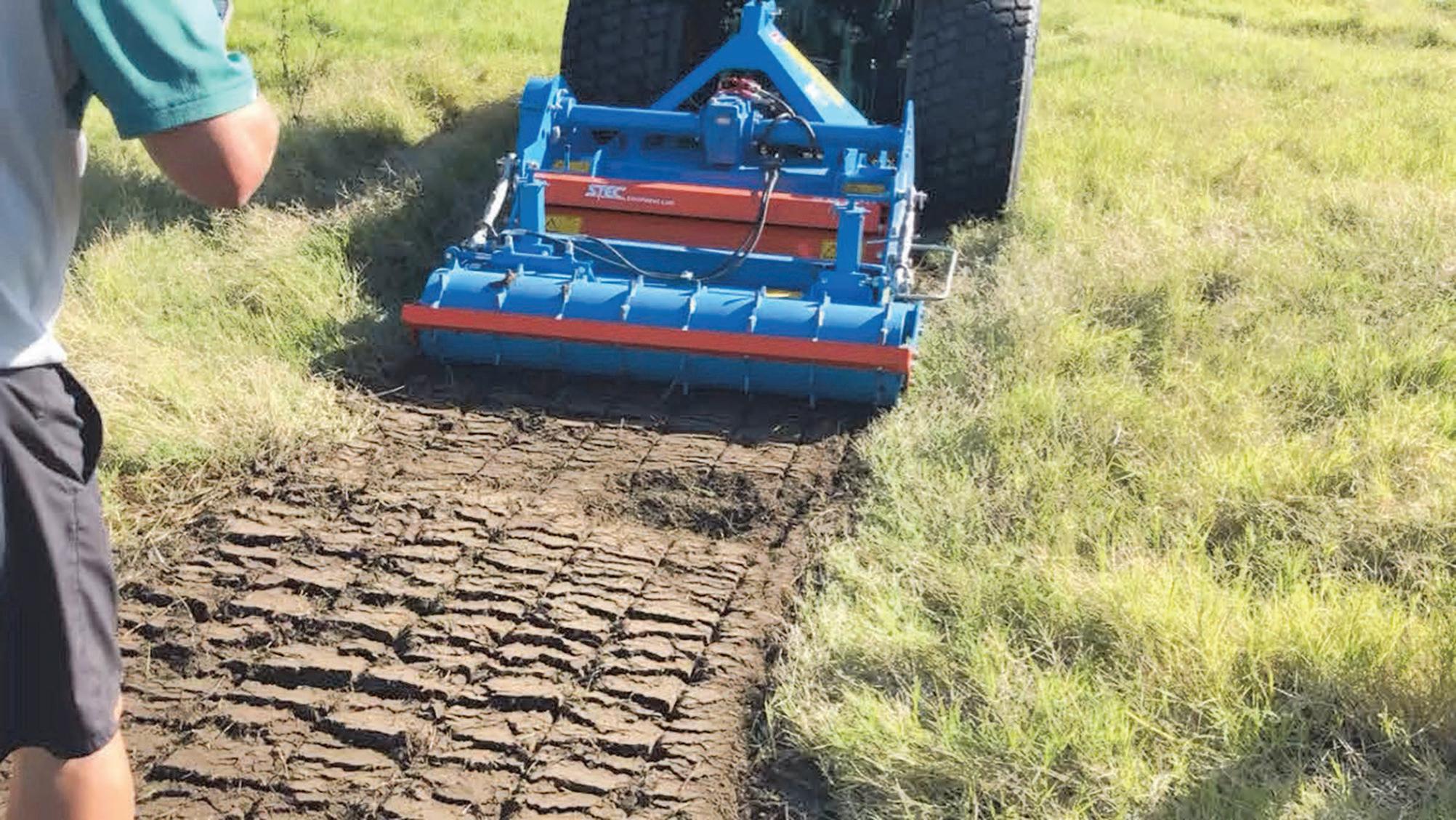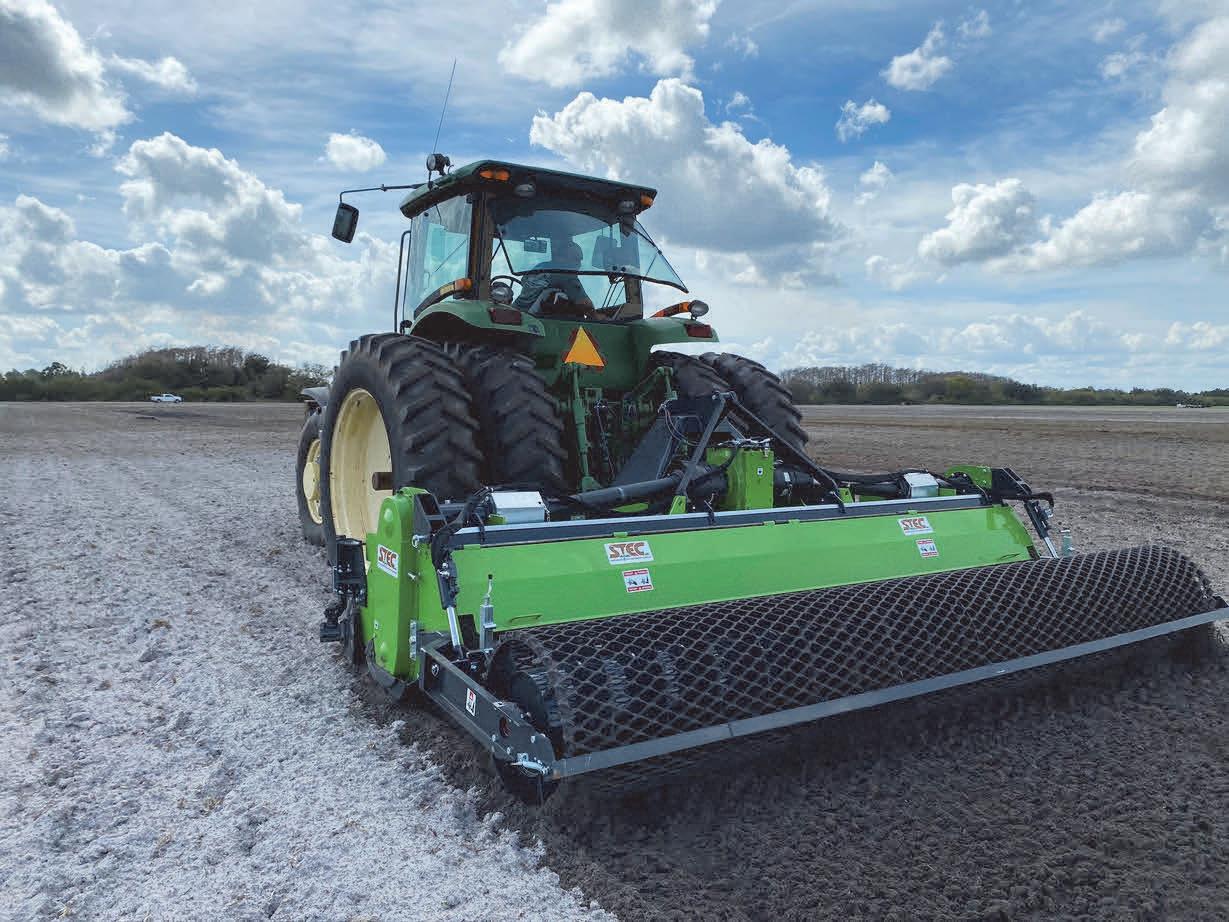
























Published by: Leading Edge Communications, LLC 206 Bridge Street, Suite 200 Franklin, TN 37064 Tel: 615-790-3718
Email: info@leadingedge communications.com
ATA OFFICERS
Josh Landreth ATA Vice PresidentHuge shout out to our sponsors, our vendors, our speakers, and so many that contributed to the success of the conference. It was great to see so many of you there, smiling, engaged, and full of energy. Attendance was up about 40%, our trade show nearly doubled, our sponsorships more than tripled. The Friday attendance was the best it has ever been! I heard there was even a cornhole tournament that broke out at the Embassy Thursday night! Numbers are great, but you can’t put a number on energy. The energy from the 2023 conference was just awesome. If you attended, thank you for being a part of that energy! Thank you Courtney Landreth for helping organize all of this, and we can’t wait to see how that positive momentum carries into 2024.
The ATA exists to serve the turfgrass industry. The success of the 2023 conference puts us in such a better place to do just that. We are now in position to start a scholarship fund. Thanks to the great education schedule that Daniel O’Brien put together, we believe that our future conferences are going to be destinations that speakers look forward to. That will help us build even better educational programs. We have plans in the works of bringing more hands on learning experiences as well.
Courtney and your board of directors have truly worked hard and so well together! It’s really been amazing to watch the entire board jump in to support the efforts of the ATA. Special thanks to our president—Richard Covert, Kyle Sanders, Guy Oyler, Rodney Fisher, Mark Brown, Ricky Self, Brandon Bradley, Jay Randolph, and Daniel Baxley. There has been so much work that has gone into all of these positive changes. It did not happen by accident, and it could not have happened if not for this group.
In the movie Elf, Santa comes back on Christmas morning and announces, “Congratulations on a successful Christmas, now it’s time to start preparations for next Christmas!” That’s how we feel! We have just finished work on the 2023 conference, and we’re already planning for 2024.
Spring is here, and all of the turfgrass community is busy, busy, busy. As you go about your daily business, don’t forget about the ATA. Plan ahead for next year’s “Site of the Year Awards.” Reach out to your colleagues to see how they are doing. Continue building relationships with your vendors that want to support you and your business. Thank you for your support at this year’s conference, and we look forward to a successful 2023!
Sincerely,
Josh Landreth ATA Vice PresidentRichard Covert, President Baptist Health Systems Richard.covert@baptist-health.org
Kyle Sanders, Immediate Past President Sanders Ground Essentials 501-315-9395 kylesanders@sandersground.com
Courtney Landreth Executive Director ataturfgrass@gmail.com
Pat Berger, Director Emeritus University of Arkansas • 479-575-6887 pberger@uark.edu
Charlie Bowen, Director Emeritus Arkansas Hydroseed • 501-315-7333 charliebowen@yahoo.com
Daniel O’Brien, Educational Chair dpo001@uark.edu
Seth Dunlap Arkansas State Plant Board seth.dunlap@agriculture.arkansas.gov 501-225-1598

Daniel Baxley Parks & Recreation Director of Mountain Home dbaxley@cityofmountainhome.com
Brandon Bradley Picture Perfect Lawns brandon@pictureperfectlawns.com
Mark Brown Nabholz • 501-749-7459 rmbrown2@ualr.edu
Rodney Fisher Agra Turf, Inc. • 501-268-7036 agrarod@yahoo.com
Josh Landreth, Vice President Ace of Blades • 479-530-7001 aceofblades@cox.net
Guy Oyler Jerry Pate Turf & Irrigation goyler@jerrypate.com • 501-317-5980
Rodger Pevehouse Life Member
Jay Randolph Sebastian County Park Admin. & Golf Course Superintendent jrandolph@co.sebastian.ar.us
Ricky Self Cypress Creek r.self@yahoo.com • 501-605-8000










Wendell Hutchens, assistant professor in U of A’s Department of Horticulture, has been named winner of the 2023 Award of Excellence by the Musser International Turfgrass Foundation.
The award is given to outstanding Ph.D. candidates who, in the final phase of their graduate studies, demonstrated overall excellence throughout their doctoral program in turfgrass research.
“It is an unbelievable honor to receive the Musser Award of Excellence,” Hutchens said. “I could not have accomplished such a feat without my foundational Christian faith; unwavering support from my wife, Anica; my family and friends; and the exceptional leadership of my mentors.”
Hutchens is in his first year as a faculty member in U of A’s Dale Bumpers College of Agricultural, Food and Life Sciences, where he primarily focuses on turfgrass pathology. Turfgrass diseases cause massive damage and losses to sod farms, golf courses, athletic fields, parks and home lawns, both in Arkansas and globally. His research centers around how to maintain healthy turfgrass and combat turfgrass diseases with traditional cultural and chemical practices, as well as with cutting-edge new technology such as drones and GPS-guided sprayers.
He received his B.S. degree in turfgrass science from North Carolina State University and went on to complete his M.S. in turfgrass pathology from NCSU. His research there focused on the influence of post-application irrigation and soil surfactant applications on fungicide movement and efficacy against root diseases. He earned his Ph.D. in turfgrass pathology at Virginia Tech where his dissertation focused on biology, epidemiology and management of spring dead spots of bermudagrass.
Hutchens has already published seven research papers for his M.S. and Ph.D. projects and has seven more awaiting publication on topics related to turfgrass pathology, turfgrass physiology and native grass implementation in the transition zone of the United States. He has already given more than 50 presentations on his research nationally and internationally.
“I am beyond grateful for the opportunity to be a faculty member at the University of Arkansas, and I hope to expand the research, extension and teaching programs during my tenure,” he said. “My mentors — including Drs. David McCall, Jim Kerns, Travis Gannon, Mike Goatley, David Shew, Mizuho Nita and Mike Richardson — have been incredible to work with and learn from. Their mentorship has taught me to be a better scientist, professional and, most importantly, person.”
He hopes to focus his career on providing applied, cuttingedge research results in turfgrass pathology, precision turfgrass management and turfgrass agronomy, as well as training the next generation of turfgrass scientists.

“There are many outstanding students in the University of Arkansas turfgrass science program, and I hope to help them reach their greatest potential,” Hutchens said. “Training tomorrow’s generation to be the best they can be is my ultimate career goal.”
The criteria for selecting award recipients include graduate work, academic record, dissertation, publications, leadership and extracurricular activities. The Musser International Turfgrass Foundation is a non-profit organization dedicated to fostering turfgrass as a learned profession, to enhancing the lives of people all over the world through turfgrass and to supporting education and research in turfgrass development and management. • This
1. What is Matrix?
• Reinforced product grown at bottom of sand based profile


• Ready to Play product
2. Where is it used?
• High demand athletic fields: football, soccer, baseball, softball, and rugby.


• High traffic areas: Horsetracks, goalmouths, and tournament crosswalks.




The 2023 ATA Turf Conference was held on January 26th –27th at the Hot Springs Convention Center. This location has proven to be a great place for members from across the state to gather to enjoy education, networking and recognizing leaders in our industry. We had approximately 210 attendees for Thursday’s session and 130 on Friday.
ATA leadership yet again put together a first-class event to support members and grow the industry through education and innovation. Be sure you plan to join us next year! •

Benton Parks and Recreation Staff received the Field of the Year Award for CW Lewis.







































 University
University
In turfgrass, the red imported fire ant (RIFA; Solenopsis invicta) is of primary concern both for its potential to create unsightly mounds and its readiness to sting anyone who disturbs it. RIFA entered the US in the 1930s and quickly spread throughout the southeastern states. Currently, RIFA continues to expand its distribution (Fig. 1) with new counties being added to the USDA quarantine map every year.
Fire ant expansion into new areas can be attributed to both active movement, with newly-mated queens flying to establish new colonies, and passive movement, through the transportation of infested plant material. RIFA queens typically fly 1 – 1.5 miles to establish a new colony and are capable of flying as far as six miles. In the case of severe flooding, fire ants can also link together to create a raft-like structure and float on the water surface into new areas.
RIFA mounds are more likely to occur in areas of high soil temperature. Turf in full sun or adjacent to an impervious surface such as cement, concrete or asphalt is more likely to attract fire ant activity, particularly in the spring. Fire ants will also take advantage of the extensive root system of trees and large ornamental plants, creating mounds near the base of these plants to use the root network to gain easy access to the water table. Unlike nuisance ants that create mounds with a hollowed-out center with an entrance hole through which they travel, fire ants create dome-shaped mounds and travel in and out via foraging tunnels (Fig. 2). Fire ants will sometimes travel for 1 – 2 feet underground before coming to the soil surface in search of food. For this reason, labeling on many bait products will indicate that baits should be placed approximately two feet from the center of a mound for individual mound treatments. This ensures that foraging
ants traveling in and out of the nest will be more likely to encounter the product.
Prior to applying any insecticide for fire ant control, it is essential to confirm fire ants are active and as close to the soil surface as possible. Early in the season, this is usually when air temperatures are in the 50s and after a significant rainfall event. Before application, ensure fire ants are active near the soil surface by placing a potato chip or slice of hot dog 1 – 2 feet from the center of a mound. If fire ants are active, they will find the source of food within 3 – 5 minutes and provide visible confirmation that it is the right time to apply ( Fig. 3 ).

Management approaches for fire ants will depend on a number of factors. Primarily, the number of mounds and required speed of efficacy will determine the best method for application. Application methods can be generally grouped into two approaches: individual mound treatments (IMT) and broadcast applications. Because you are treating each mound individually, this approach is more time-consuming and require large volumes for an effective application. Formulation selection is less important than choosing an appropriate active ingredient, however, for IMT applications, it is best to choose one that has contact activity against fire ants. In an IMT, mounds should be left undisturbed until the equipment and applicator are ready. Products can be applied through soil drench or injection to the top of the mound and should be applied in a large volume to flood down through the tunnels and fill the nest chambers of the mound (Fig. 4). Ideally, enough volume is applied to reach the queen that is likely deep underground. If you are able to reach the queen, this approach can provide long-lasting control and generally uses less product compared to broadcast treatments, which can minimize impact on offtarget beneficial insects in the landscape.

 Figure 3: Fire ants foraging on hot dog slice
(Photo Credit: B. Royals, NC State University)
Figure 4: Dry formulation application to Fire Ant Mound Layton, B. “Control.” Fire Ants, Mississippi State University, http://extension.msstate.edu/content/control.
Figure 2: Cross-section of Fire Ant Mound Greenberg, L., and J.N. Kabashima. Red Imported Fire Ant: Integrated Pest Management In and Around the Home. Edited by K. Beverlin, UC-IPM, Dec. 2013, https:// ipm.ucanr.edu/pdf/pestnotes/pnredimportedfireant.pdf. Adapted from Texas Agric. Exten. Serv. File photo.
Figure 3: Fire ants foraging on hot dog slice
(Photo Credit: B. Royals, NC State University)
Figure 4: Dry formulation application to Fire Ant Mound Layton, B. “Control.” Fire Ants, Mississippi State University, http://extension.msstate.edu/content/control.
Figure 2: Cross-section of Fire Ant Mound Greenberg, L., and J.N. Kabashima. Red Imported Fire Ant: Integrated Pest Management In and Around the Home. Edited by K. Beverlin, UC-IPM, Dec. 2013, https:// ipm.ucanr.edu/pdf/pestnotes/pnredimportedfireant.pdf. Adapted from Texas Agric. Exten. Serv. File photo.
Broadcast treatments are quick and easy to apply – usually in a spreader or sprayer – to cover large areas. Liquid or granular formulations with contact activity can be effective, however, only ants active at the soil surface will be impacted. Depending on active ingredient, these applications may not have an effect on the colony. An exception to this would be products containing fipronil which will provide much longer lasting control. Unlike IMTs, broadcast applications will impact beneficial insects within the landscape, including native ant species.

Bait products can be applied in either an IMT or broadcast application and can also provide more long-lasting control. Baits must be placed two feet from the center of the mound and kept fresh and dry in order to be effective. If there is significant dew formation on the turf, wait until the areas have dried before placing a bait product. If fire ant control is needed but there is consistent rain in the forecast, give yourself at least a 5-6 hour window for fire ants to forage, find the bait, and bring it back to the nest before it rains. Bait products are considered more “slow-acting” than contact insecticides and provide control within 3 – 14 days of application, depending on active ingredient. See Fig. 5 for a complete list of active ingredients by application method and speed of efficacy.
Biological control options for fire ants are limited. Botanical or plant-derived products are generally not effective. Products containing spinosad, a soil bacterium, can be effective against fire ants but results are inconsistent. Biocontrol products are generally sensitive to environmental conditions and can be negatively affected by prolonged sun exposure, hot temperatures and dry conditions.
As we start to see temperatures increase, keep an eye out for fire ant activity, particularly following significant rainfall events. In North Carolina, we tend to see a sharp uptick in fire ant activity in late February and early March. Early spring is a great time to get a head start on fire ant control, particularly with insecticides with longer residual or bait products. Unlike other insects in turf, fire ants are very consistent and tend to be an issue in the same areas from year-to-year. The key to effective management is to 1) always make sure fire ants are foraging prior to making an application and 2) select the appropriate application method and product for control. For additional resources, be sure to check out NC Turf Bugs (“Resources” tab) for specific fire ant control and quarantine information. •
1. Should I disturb the nest to bring the ants to the surface before drenching?
a. Applicators should drench the mound surface first and then break open the mound with a talc-coated shovel to saturate the interior of the mound.



2. Do fire ants sting or bite…or both?
a. Fire ants sting and cause a skin reaction (blister) where the venom is injected. For most people, it’s an itchy annoyance that lasts a week or two. However, in sensitive individuals, reactions are more severe and can require hospitalization. Fire ants do have mandibles (teeth) that they can use to latch on to the skin while they sting. For that reason, the best way to remove fire ants from your body is to wipe points of contact with your hands to physically separate the mandibles from the skin and remove the fire ants.
3. Do fire ants prefer certain soil types?
a. We observe them more often in clay soils but a lot of that has to do with areas where they are most prevalent. They will infest and inhabit basically any type of soil.

4. Can they be moved from place to place on a mower? Or, are they located in mulch?
a. Yes, it is pretty easy to move individual ants from one place to another on any equipment/vehicles. However, unless you move a newly-mated female to a new area, individual ants are not going to establish new colonies. It’s possible that you can have fire ants in a big (and undisturbed) pile of mulch, but the activities of loading and unloading of that mulch generally disrupt and scatter the colony (if there was an entire colony in one). There are generally a bigger problem in stacks of wheat straw that may be used after seeding a new lawn. If these stacks are undisturbed for months, fire ants might relocate a nest under or in a bale. As such, we recommend keeping the bales off the ground in storage.
A winning combination for Spring.




products are blended to feed plants, improve soil fertility and build topsoil.

